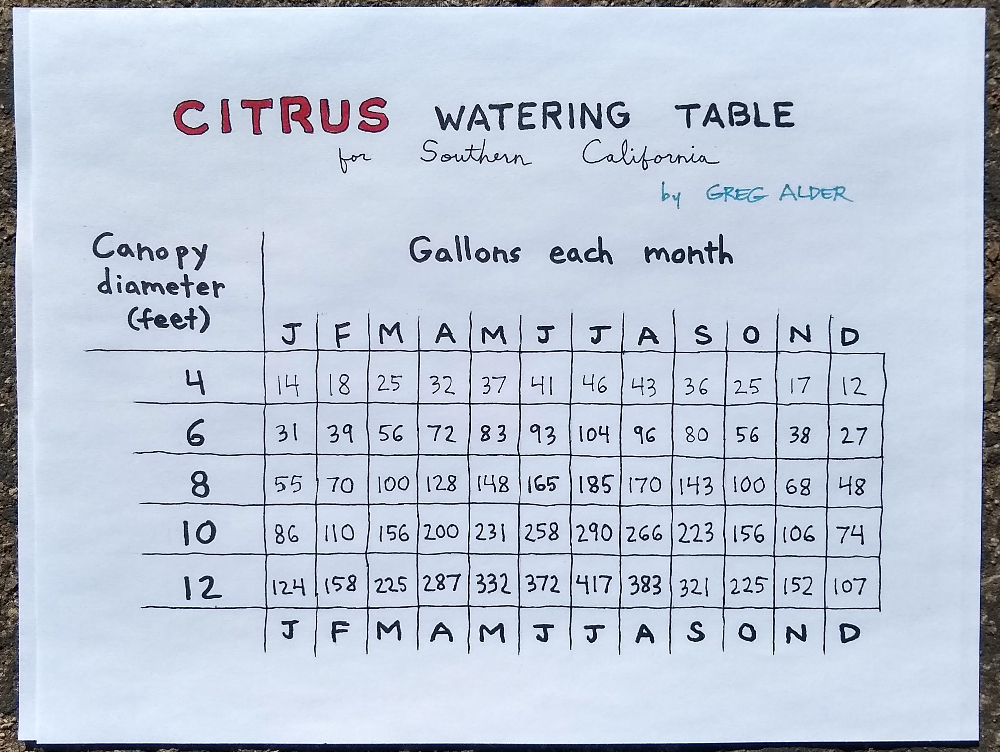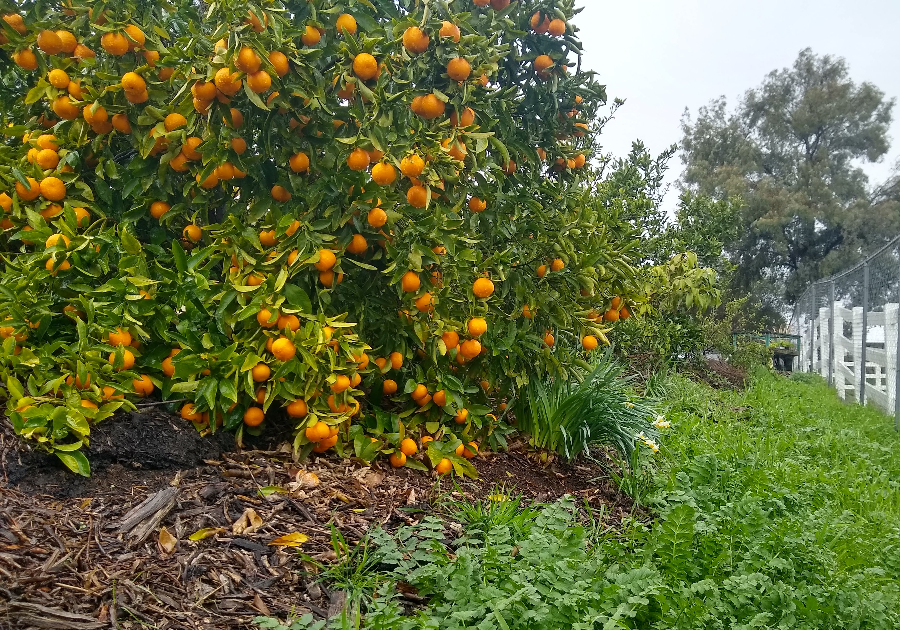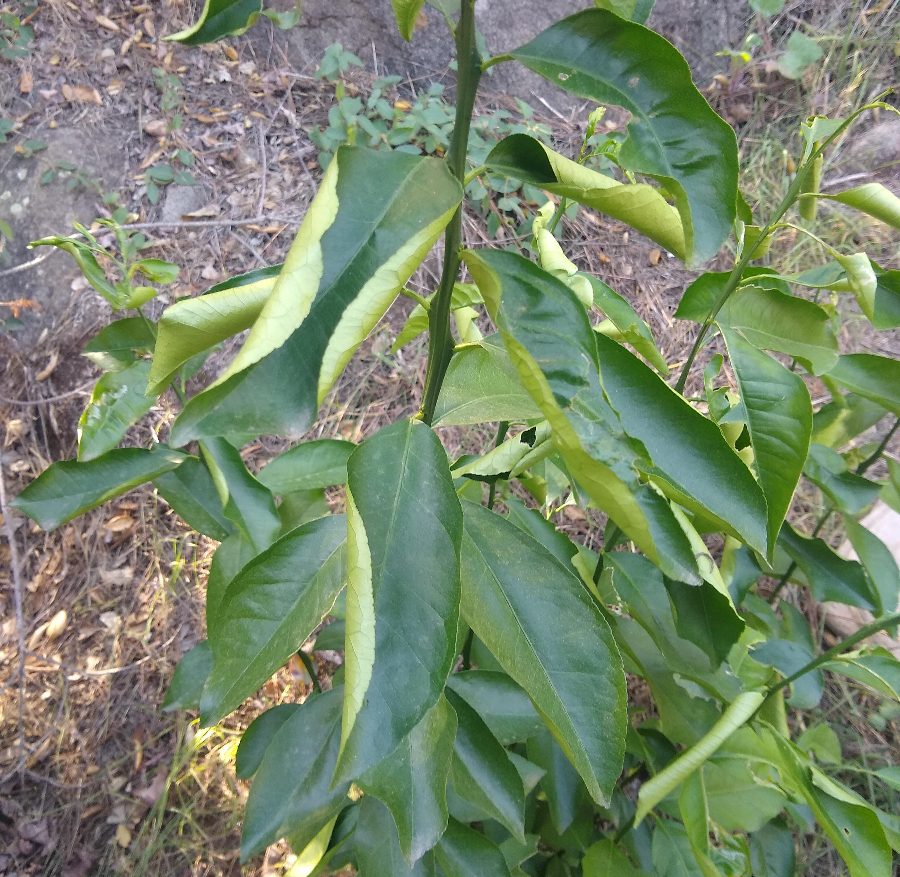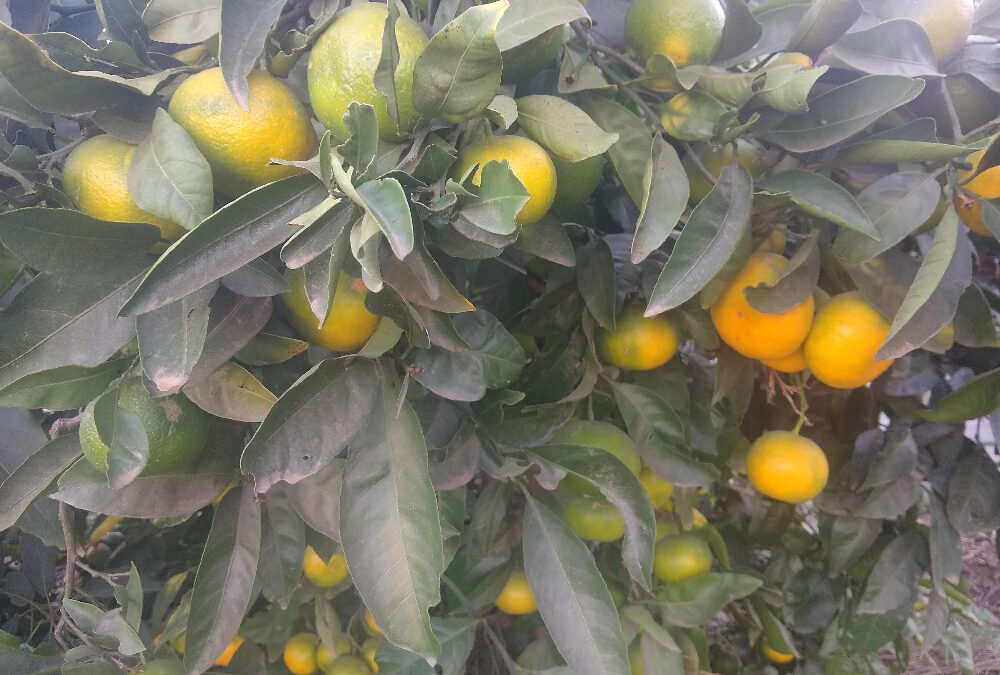As the weather cools in fall and the citrus fruit on my trees start turning from green to yellow, they catch my eye. It’s been so long since I’ve eaten a tangerine or a navel orange. I can’t wait until this new crop is ripe.
And I look at the amount of fruit on the trees and the amount of new growth, and I ask myself if I’ve been watering enough. Or have I been watering too much? How much have I been watering to get the results I’ve got?
I keep records of my irrigations and I use drip emitters so it is easy to do the calculations. So I did them.
After doing them, I compared the numbers to those in a table by UC Riverside researchers (for the Riverside area). Wow! I water way less than they recommend. I don’t know how they came up with their numbers, but I know that I would be wasting a lot of water if I used their table, and I might be causing problems in my trees as well.
My watering table
Here are my numbers. This is about how many gallons my citrus trees get in order to perform the way they do:

How often?
Over the years, I have gotten good performance from my trees while watering them anywhere from daily to every two weeks (in summer). Last summer, I watered most of my citrus two times per week (on drip). Citrus trees are comfortable getting water in a broad range of frequencies.
When choosing my frequencies, I keep a few things in mind. Young trees need water more often than old trees. And if you use drip irrigation, you need to water more often compared to sprinklers or bubblers.
(I currently use drip irrigation on all of my citrus trees, but in the past I used mini-sprinklers. Both methods work great, as do many other methods, including bubblers, a hose with a spot sprinkler, etc.)
Your watering table
How can this table be of use to you? First, you have to compare your location to mine. I am in Ramona, San Diego County, which is within Zone 9 of this evapotranspiration map. Other cities in this zone are Valley Center, Redlands, Rancho Cucamonga, and Simi Valley. If your citrus trees are in a cooler or hotter spot, then adjust accordingly.
Use this spreadsheet made by Yard Posts Supporter, Robert M., which can instantly adjust my watering table for different zones in California.
Also note that rain is not accounted for. Any time we get rain of at least 0.5 inches, the irrigation the citrus trees need is reduced. In practice, I only occasionally find the need to give my citrus trees any irrigation from December through March.

Pay attention to the plants surrounding your citrus tree. Sometimes there are bushes or other trees that drink some of the water you give your citrus tree, thereby requiring that you add more.
Judge your watering by the look of the trees. Are they growing? Is the fruit getting to the expected size?
It’s my observation that most citrus trees in Southern California are watered too much rather than not enough. Overwatering citrus seems to be the most common inclination.
That said, if your citrus tree is not getting enough water it will display its thirst by folding its leaves more than normal.

(For help in reading other symptoms in citrus leaves, see my post: “Reading citrus leaves.”)
What I’d love to see more people do is find the water needs of their citrus trees by backing off the water until the trees show leaf fold. Find that lower limit. Fruit and the health of the trees will not be sacrificed by testing this, as long as you irrigate soon after the tree shows its thirst.
Citrus trees are tough, especially as they age. I have deliberately backed off on the water to many of my citrus trees in order to test this and found no lasting damage while reaping the benefits of knowing how much water my trees really need.
(See this post for an extreme example: “Unirrigated fruits and vegetables.”)
Please share with me your results if you explore this with your citrus trees.
All of my Yard Posts are listed HERE
Thank you for your support, as it allows me to keep the website ad-free!




Interesting, thank you! We have a mature navel orange that we’ve never watered in the three years we’ve been here. I think it helps that the fruit finishes in the rainy season, because everything else seems to want a lot of water in the summer. I figure I’ll leave it be unless it starts to look weird– it makes small but delicious and very plentiful oranges.
Hi Jessica,
What a deal! I’ve never thought about the fruit’s season as a factor, but that makes sense.
Thank you very much! I have just one tree 🌳 ☺️ but you sure gave great information 👍 but I love my tree 🌳 ❤️ I better water it now!!!
We in rural hilly areas in Nepal realise that all types of citrus fruits have a good yield of fruit if watered in plenty particularly in dry season. Unfortunately we have always a severe shortage of water . Your advise confirms our understanding. Thank you.
Thanks Greg I just have two citrus trees, but I wonder if it’s too much water. I have many yellow leaves, especially on my Meyer lemon, which has massive amounts of fruit on it ripening right now. I called the nursery and they told me to use iron and zinc, which I did, can’t tell if it helped. I have applied twice. I need to look for more citrus growing articles on your website.
Hi Sally,
Whenever I see a citrus tree with yellow leaves, I want to scratch into the dirt below to check for sogginess and look around for moss. I always suspect overwatering and want to eliminate that factor first.
It’s true that yellow on citrus leaves can be caused by nutrient deficiencies, but sometimes the deficiencies are themselves caused by overwatering.
I’ve never seen an underwatered citrus tree that has yellow leaves. I’m sure some exist, but I’ve never seen one. I have four old citrus trees of different types in my yard that get zero irrigation, and they don’t fruit much (and the fruit is always small), but their leaves are never yellow.
There can be toxicities in the soil too, and it can be hard to distinguish them from deficiencies, and I’m told that the two can be related. I’ve got a couple citrus trees in one spot in my yard that have never looked good, with strange patterns of yellowing on leaves that I suspect are from nutrient deficiencies or toxicities, although the trees do grow and fruit. I’ve always wondered if long ago someone disposed of something in the dirt there.
By the way, this is a useful page of images for diagnosing citrus leaf symptoms: https://ipm.ucanr.edu/PMG/C107/m107bpleaftwigdis.html
My citrus (and other fruit trees) are all hand watered so it is always so difficult for me to know exactly how much water they are getting. I’m in Altadena and have seemed to get away with almost no watering over the winter, weekly watering once the rains end, with an occasional extra water when we have heat waves. I think my trees are probably underwatered but so far they are still alive and kicking out fruit (though no fruit on my 5+ Haas avocado.)
Are there any tips for citrus trees in CA central valley? Bakersfield to be exact
Hi Vicente,
Try using the spreadsheet made by Robert M. now listed above, and use zone 15 for Bakersfield. Here is the spreadsheet: https://docs.google.com/spreadsheets/d/1p0m24J5cmjqQSsPMXBJ1FZA5V8kv8eQ8U-iTmQYcD78/edit#gid=0
Hi Greg: Thank you for another great post. I really like the spreadsheet for citrus irrigation amounts you published Nov 10, 2023 (by Robert M). I spent hours on the CIMIS site. They have 247 stations listed but only about 50% are active so i used both Torrey Pines (#173;Zone 1) and San Clemente (#241 Zone 4) to judge my needs in Oceanside. Can you confirm from your Avocado tree watering table that a 10’ canopy avocado should have 120 gallons (4gal x 30 days) in the month span of November? Thank you again
Hi Joe,
That’s right for November on the avocado table.
I hope it’s not confusing that I used gallons per day on the avocado table but gallons per month on the citrus table. I chose to do gallons per month on citrus because citrus can go much longer between waterings than avocados.
Hi Greg, quick question…is there a direct link to your avocado watering table? Thanks!
Hi Greg, I have avocados and citrus in my yard. I just finished reading the irrigation post on avocados regarding the sprinkler spinners that you use. In this article about irrigation of citrus you talk about frequency but not the actual delivery. Do you use/recommend the sprinklers/spinners for citrus like you use on the avocados? Or do you like to actually use drip emitters?
Thanks
Hi Chris,
I should add that into my post.
I currently use drip on all of my citrus, but in the past I used mini-sprinklers on most of them. Both methods work great, but I prefer drip slightly for my situation.
It so happens that I also use drip on most of my avocados now too. I haven’t found a difference in performance between avocado trees or citrus trees on sprinklers versus drip. The most important thing seems to be the delivery of the right amount of water at the right times, regardless of delivery method.
I just goggled a subject on citrus and water and found you at the top of the list. You’ve been googled! I read your emails every week.
Murrieta CA
Hi
We have talked before… I live by the lagoon in Del Mar (near Roberto’s). For the life of me I can’t get a lime tree to live let alone produce. Oranges and lemons are great. Any ideas?
What gph drip emitters do you use? And how many per tree?
Hi Jessica,
I use 0.5 GPH emitters spaced one foot apart on most of my citrus, and I use just a single line in a circle under each tree’s canopy edge. So the number of emitters varies: a larger tree has more emitters.
I use the “pigtail” arrangement, as shown in this post: https://gregalder.com/yardposts/watering-fruit-trees-with-drip-irrigation/
Hello Greg. I’m in zone 10, also in San Diego County but a bit closer to the coast. Your blog is so extremely helpful. 95% of advice out there typically says “you just gotta feel the soil, conditions may vary, it really depends”, etc. No starting point to at least anchor myself to as I begin my journey with my citrus trees. Your posts have been the best, giving me a solid place to start.
Not sure how I else I could show my gratitude but to drop a comment here and say that you’ve helped immensely. May your harvests forever be plentiful. Thanks!
Thank you for taking the time to write this kind message, Teresa!